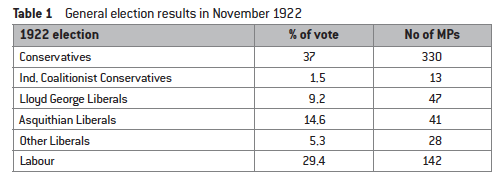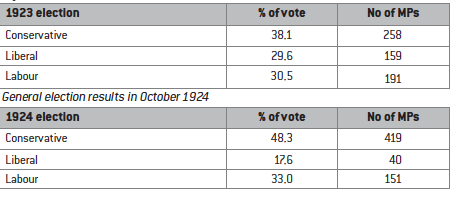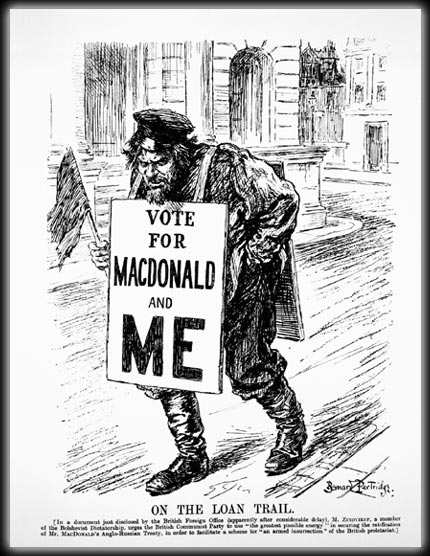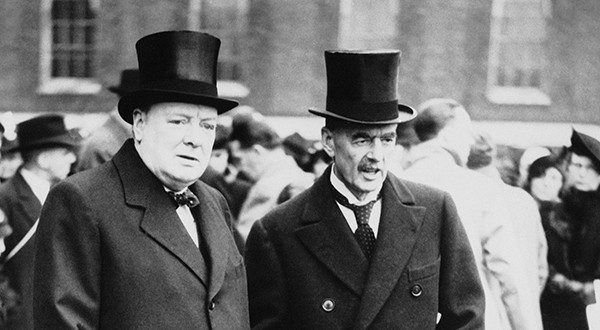1. Political developments 1922 - 1929

The years 1922 to 1929 saw dramatic swings in the fortunes of the Liberal and Labour Party, and the continued success of the Conservative party.
The end of the coalition in 1922 led to three elections in quick succession. The first election after the end of the coalition, in 1922, was won by the Conservatives led by Bonar Law. However, Bonar Law was forced to resign after only eight months. In his place, the King chose Stanley Baldwin who decided that the best way to tackle unemployment was to return to a policy of protection![]() . He decided to call another election on the issue of tariff reform in order to get a mandate for his plans, but this turned out to be a rather rash decision. Although the Conservatives remained the largest party in the Commons, both the Liberals (who united in support of free trade) and the Labour Party increased their share of the vote. Stanley Baldwin was forced to resign in January 1924 after a vote of no confidence. A Labour minority government, dependent on the support of the Liberals, was now formed under Ramsay MacDonald - but this too ended in 1924 after being defeated in a motion of no confidence.
. He decided to call another election on the issue of tariff reform in order to get a mandate for his plans, but this turned out to be a rather rash decision. Although the Conservatives remained the largest party in the Commons, both the Liberals (who united in support of free trade) and the Labour Party increased their share of the vote. Stanley Baldwin was forced to resign in January 1924 after a vote of no confidence. A Labour minority government, dependent on the support of the Liberals, was now formed under Ramsay MacDonald - but this too ended in 1924 after being defeated in a motion of no confidence.
 Election results for the 1922, 1923 and 1924 elections
Election results for the 1922, 1923 and 1924 elections
What can you learn from these election results regarding the fortunes of the different parties?

During this process, the Liberal Party, which had dominated British politics from 1906 to 1915, faded into the background. The battle now became between the Conservative Party and the Labour Party.
The decline of the Liberal party was due to a number of factors:
Impact of the war: The divisions among the Liberals that developed during the war continued to have an effect. The split between Asquith and Lloyd George was never properly healed. Although they came together in 1923 to fight the election, the reunion was unconvincing; both sides remained suspicious of each other. In addition, government measures during the war such as the introduction of conscription and DORA meant that Liberal values which centred on the freedom of the individual and the concept of ‘laissez-faire’, had been severely challenged.
Impact of Liberal legislation: The social reforms introduced by the Liberals had been far-reaching, but they marked the limits of how far most Liberals were prepared to go in this area. Thus, working classes needed to look elsewhere for further reforms.
Electoral costs: Both the Conservative and the Labour parties had substantial sources of income. The Conservatives could count on donations from the business world and the Labour Party received funds from trade unions which increased as trade union membership grew. The Liberal party had no similar source of income. This meant that its election campaigns were relatively limited.
The electoral system: As indicated by the tables of the different elections above, the Liberals were disadvantaged by the British electoral system known as ‘first past the post’. Although the Liberals, for instance had a similar percentage of votes to Labour in the 1923 election, it could not translate these into seats. This also made it less attractive to voters who were reluctant to ‘waste’ their vote.
Within Parliament they could no longer rely on the parliamentary support of the Irish Nationalists as they had done before 1914, as Sinn Fein had boycotted the House of Commons in 1918 and Home Rule for southern Ireland was implemented in 1922.
Loss of traditional support: By 1918, the Labour party had a new constitution ensuring trade union dominance, and increasingly workers realised that their interests lay in voting Labour. The most enthusiastic supporters of the Liberals had been nonconformists, but the nonconformist churches were declining rapidly in numbers and enthusiasm.
Several factors account for this remarkable number of seats won by the Labour party:
- Working class voters now switched allegiance from the Liberal to the Labour Party; Labour policies were much more relevant to their post-war needs.
- The Labour Party was now organised and well-funded. It had improved its constituency organisation during the war which allowed it to put candidates in most constituencies in 1922. It adopted a formal constitution in 1918 which set out a distinct programme. In addition, funds from the trade unions gave it strong financial backing.
- The Labour Party had gained experience in government during the war; this had allowed it to prove that it was a patriotic party and that it could be trusted with power.
The Conservatives were the dominant force in the 1920s, and indeed would continue to be so until the outbreak of war in 1939. Following their influential position in Lloyd George’s coalition from 1918 to 1922, they went on, after their break from the Liberals, to form the government of Britain up to 1929. The only exception was the nine-month period that you have just read about, under the Labour government.
There were several reasons for this Conservative dominance.
Impact of the First World War: The war had split the Liberal Party and brought the Conservatives into the coalitions where they played a key role and gained valuable ministerial experience. The war also allowed the Conservatives to highlight their traditional values; patriotism, strong defence and protection of the Empire were all important during wartime.
Electoral change: The electoral changes at the end of the war benefited the Conservatives. The Representation of the People Act (see previous page) preserved ‘plural voting’. This meant that owners of business premises outside their constituency of residence could vote twice, and graduates could also vote for university seats; both of these categories of voters were likely to be Conservative. The redistribution of seats in the Act favoured the Conservatives as several ‘safe’ seats in the South of England in the Home Counties were subdivided into more ‘safe’ seats. Moreover, it appears that the female voters who were enfranchised in 1918 largely voted for the Conservative Party.
Post-war events in Ireland: These further benefited the Conservatives as after 1922 and the Anglo-Irish Treaty, the Irish Nationalists who had previously supported the Liberals now sat in their own parliament in Dublin. The only Irish MPs left at Westminster were those from Ulster, who were pro-Conservative.
Broad-based support: The Conservative Party had the support of wealthy, upper-class Britons. However, it also had the support of much of both the middle and the working class. This broad appeal came from its association with national unity, patriotism, King and empire as well as its emphasis on self-reliance. In comparison to, what seemed to many, the radical policies of the Labour Party and the Liberals, the Conservatives could portray themselves as both moderate and unified.
Funding : The wealth of the upper classes provided the Conservatives with valuable funds which helped to conduct highly organised election campaigns and to contest every single constituency in the country at election time.
Organised campaigning: The Conservatives had more paid professional agents than other parties. They were the first party to employ an advertising agency for the 1929 election and issued more printed material than any other party – four leaflets per voter in 1929. They also developed a larger party membership with an estimated million members of Conservatives’ women’s branches by 1930.
Newspaper support: The newspapers were largely owned by Conservative supporters who thus gave the party favourable news coverage during elections.
1. Create a mind map to show the reason for the Conservative dominance. Use the following headings to organise your information.
- Impact of the First World War
- Disunity of the opposition
- Broad appeal of the Party
- Financial support
- The electoral system
- Party organisation
- Luck (see below for information to add to this)
2. In pairs discuss the extent to which you consider the resurgence of the sustained dominance of the Conservative Party to have been more due to the weaknesses and divisions of the opposition parties, rather than the strength of the Conservative Party
Domestic policy
Ramsey MacDonald’s aim in 1924 was ‘to gain the confidence of the country’. He intended to avoid radical policies and to show that Labour was capable of running the government and keeping the British Empire safe. Thus no changes were made with regard to colonial rule, defence spending, parliamentary or cabinet procedures. Some changes were made in the area of social services; old age pensions and unemployment benefits were raised and state scholarships to universities, were revived. However, the extra spending involved was small. Indeed, Philip Snowden who was Chancellor of the Exchequer, despised borrowing money and was determined to keep expenditure down. The Labour Government also showed that it would not be dictated to by trade unions; strikers during these months did not receive preferential treatment.
Foreign affairs
Labour also played a successful in foreign affairs, helping to facilitate the Dawes' Plan that was set up to help Germany pay its reparations after the 1923 Ruhr crisis. This agreement, helped institute a period of optimism in international relations. MacDonald’s visit to the League of Nations (the first and only British Prime Minister to do so) and his clear commitment to the ideals of the League and to disarmament, further strengthened the international situation.
Why did this government end?
More controversial, however, were the Labour party’s relations with Russia.
Watch the first 5 minutes of this video:
- What actions of the Labour Party meant that it was accused of being 'soft on Communism'
- How did his lead to the calling of another election?
- What was the Zinoviev Letter published in the Daily Mail? Why was it so incendiary?
- What was the impact of the letter on the 1924 election?
If you are interested in the controversy surrounding the Zinoviev Letter, and the conspiracy theories surrounding the letter, and whether or not it was in fact even genuine, continue watching the video!
 1. What is the message of this Punch cartoon?
1. What is the message of this Punch cartoon?
2. According to MacDonald below, what were the achievements of the first Labour Government?
What evidence is there to support each of MacDonald’s claims?
Prime Minister Ramsay MacDonald summarised the achievements of the first Labour Government in a letter to the King shortly before the October 1924 election:
They have shown the country that they have the capacity to govern in an equal degree with the other parties in the House and, considering their lack of experience, have acquitted themselves with credit in the House of Commons. The Labour Government have also shown the country that patriotism is not the monopoly of any single class or party. Finally, they can justly claim that they left the international situation in a more favourable position than that which they inherited. They have in fact demonstrated that they, no less than any other party, recognise their duties and responsibilities, and have done much to dispel the fantastic and extravagant belief which at one time found expression that they were nothing but a bunch of irresponsible revolutionaries intent on wreckage and destruction.

Baldwin ‘captured the spirit of the age; the widespread desire for tranquillity at home, peace and disarmament abroad, and a return wherever possible to pre-war verities’
The Stuart Ball, Conservative Party and British Politics 1902 – 51, 1995, pg 79,
Under Baldwin, the government carried out a series of reforms that showed that the Conservatives were willing to accept the idea that government intervention was necessary in some areas for the public interest.
- In 1926, an Electricity Act set up the Central Electricity Board (CEB) which created modern power stations and an effective power grid to distribute current over the whole country. This substantially improved the efficiency of the electricity industry.
- At the same time, The British Broadcasting Corporation (BBC) was established, which set up a national radio broadcasting system.
- In 1928 the Representation of the People Act gave votes to women aged 21 and over, thus putting the franchise on equal terms for men and women. The electorate increased from 22 million to 29 million; there were now two more million women than men voters.
In addition important economic and social reforms were introduced by Chamberlain who was Minister of Health. A Contributory Old Age Pension meant that workers and wives received a pension of 10s a week at the age of 65. Widows’ pensions were also introduced. Meanwhile the National Insurance Act of 1925 meant that unemployment insurance could now be claimed indefinitely providing the worker was ‘genuinely seeking work’.

Chamberlain’s most extensive reforms affected local government. The Local Government Act of 1929 gave local authorities extra duties concerning roads, public health, maternity and child care; they now had greater responsibility than anywhere else in Europe. To help pay for these services all farms and 25 per cent of factories were except from local rates. It was hoped that this ‘de-rating’ would stimulate industry and commerce and make employers more willing to take on extra workers. The Act also ended the Poor Law by abolishing the Boards of Guardians and phasing out workhouses.
The major issues that the Conservative government had to deal with were economic. In a surprise appointment Baldwin appointed Churchill, who now crossed back from the Liberals to join the Conservative Party, as Chancellor of the Exchequer. Controversially, Churchill restored the pound to the gold standard. This meant increasing its value by 10 percent which may well have caused more economic problems for Britain. (see next page)

 IB Docs (2) Team
IB Docs (2) Team
